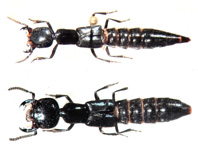Abstract
Acanthobothrium ningdense n. sp. and Acanthobothrium guanghaiense n. sp. are described from the spiral intestine of the whip stingray, Dasyatis akajei (Müller & Henle). Acanthobothrium ningdense n. sp. is reported based on 38 cestode specimens collected at five locations along the Chinese coast, i.e. Taizhou, Zhejiang Province, Ningde and Xiamen, Fujian Province, Taishan, Guangdong Province and Sanya, Hainan Province between 2012 and 2015. Acanthobothrium ningdense n. sp. belongs to the “species category 4” characterised by Ghoshroy & Caira. Among category 4 Acanthobothrium species, A. ningdense n. sp. most closely resembles A. micracantha Yamaguti, 1952 and A. latum Yamaguti, 1952, both from the same host species. Acanthobothrium ningdense n. sp. differs from A. micracantha by lacking a long robust hook handle that connects the bases of medial and lateral hooks, and from A. latum by having much longer axial prongs than abaxial prongs. Acanthobothrium guanghaiense n. sp., only found in Taishan, Guangdong Province in 2014, is a category 2 Acanthobothrium species. Among category 2, A. guanghaiense n. sp. most closely resembles A. semnovesiculum Verma, 1928, but can be differentiated from it by the arrangement of testes (in two staggered columns rather than in two tandem columns), and the shape of abaxial prong (nearly straight instead of with a conspicuous curve in the proximal portion). Acanthobothrium macrocephalum Wang & Yang, 2001 is redescribed based on new specimens collected from D. akajei in Guanghai and Sanya. With this study, the total number of Acanthobothrium species reported from D. akajei is brought to nine. It is possible that some of the species of Acanthobothrium previously reported from D. akajei not encountered in this study may have geographically restricted distributions, as was observed here for A. guanghaiense n. sp..
References
Caira, J.N. & Burge, N.A. (2001) Three new species of Acanthobothrium (Cestoda: Tetraphyllidea) from the ocellated electric ray, Diplobatis ommata, in the Gulf of California, Mexico. Comparative Parasitology, 68, 52–65. Caira, J.N., Jensen, K. & Barbeau, E. (2012) Global Cestode Database. World Wide Web electronic publication. University of Connecticut, Storrs, CT, USA. Available from: http://www.tapewormdb.uconn.edu (accessed 13 December 2015)
Caira, J.N., Jensen, K., Waeschenbach, A., Olson, P.D. & Littlewood, D.T.J. (2014) Orders out of chaos—molecular phylogenetics reveals the complexity of shark and stingray tapeworm relationships. International Journal for Parasitology, 44, 55–73.
http://dx.doi.org/10.1016/j.ijpara.2013.10.004Campbell, R.A. & Beveridge, I. (2002) The genus Acanthobothrium (Cestoda: Tetraphyllidea: Onchobothriidae) parasitic in Australian elasmobranch fishes. Invertebrate Systematics, 16, 237–344.
http://dx.doi.org/10.1071/IT01004Chervy, L. (2009) Unified terminology for cestode microtriches: a proposal from the International Workshops on Cestode Systematics in 2002–2008. Folia Parasitologica, 56, 199–230.
http://dx.doi.org/10.14411/fp.2009.025Fyler, C.A. & Caira, J.N. (2006) Five new species of Acanthobothrium (Tetraphyllidea: Onchobothriidae) from the freshwater Stingray Himantura chaophraya (Batoidea: Dasyatidae) in Malaysian Borneo. Journal of Parasitology, 92, 105–125.
http://dx.doi.org/10.1645/GE-3522.1Fyler, C.A. & Caira, J.N. (2010) Phylogenetic status of four new species of Acanthobothrium (Cestoda: Tetraphyllidea) parasitic on the wedgefish Rhynchobatus laevis (Elasmobranchii: Rhynchobatidae): implications for interpreting host associations. Journal of Invertebrate Systematics, 24, 419–433.
http://dx.doi.org/10.1071/IS10034Fyler, C.A., Caira, J.N. & Jensen, K. (2009) Five new species of Acanthobothrium (Cestoda: Tetraphyllidea) from an unusual species of Himantura (Rajiformes: Dasyatidae) from northern Australia. Folia Parasitologica, 56, 107–128.
http://dx.doi.org/10.14411/fp.2009.016Ghoshroy, S. & Caira, J.N. (2001) Four new species of Acanthobothrium (Cestoda: Tetraphyllidea) from the whiptail stingray Dasyatis brevis in the Gulf of California, Mexico. Journal of Parasitology, 87, 354–372.
http://dx.doi.org/10.1645/0022-3395(2001)087[0354:FNSOAC]2.0.CO;2Goldstein, R.J. (1967) The genus Acanthobothrium van Beneden, 1849 (Cestoda: Tetraphyllidea). Journal of Parasitology, 53, 455–483.
http://dx.doi.org/10.2307/3276705Ivanov, V.A. (2005) A new species of Acanthobothrium (Cestoda: Tetraphyllidea: Onchobothriidae) from the ocellate river stingray, Potamotrygon motoro (Chondrichthyes: Potamotrygonidae), in Argentina. Journal of Parasitology, 91, 390–396.
http://dx.doi.org/10.1645/GE-354R1Maleki, L., Malek, M. & Palm, H.W. (2015) Four new species of Acanthobothrium van Benden, 1850 (Cestoda: Onchoproteocephalidea) from the guitarfish, Rhynchobatus cf. djiddensis (Elasmobranchii: Rhynchobatidae), from the Persian Gulf and Gulf of Oman. Folia Parasitologica, 62, 012.
http://dx.doi.org/10.14411/fp.2015.012Maleki, L., Malek, M. & Palm, H.W. (2013) Two new species of Acanthobothrium (Tetraphyllidea: Onchobothriidae) from Pastinachus cf. sephen (Myliobatiformes: Dasyatidae) from the Persian Gulf and Gulf of Oman. Folia Parasitologica, 60, 448–456.
http://dx.doi.org/10.14411/fp.2013.048Masuda, H., Amaoka, K., Araga C., Uyeno, T. & Yoshino, T. (1984) The fishes of the Japanese Archipelago. Vol. 1. Tokai University Press, Tokyo, 437 pp.
Marques, F., Brooks, D.R. & Monks, S. (1995) Five new species of Acanthobothrium van Beneden, 1849 (Eucestoda: Tetraphyllidea: Onchobothriidae) in stingrays from the Gulf of Nicoya, Costa Rica. Journal of Parasitology, 81, 942–951.
http://dx.doi.org/10.2307/3284046Pramanik, P.B. & Manna, B. (2010) On three new species and two known species of the genus Acanthobothrium van Beneden, 1849 (Cestoidea: Onchobothriidae) from the cartilaginous fishes from Digha water, Bay of Bengal, India. Journal of Natural History (India), 6 (1), 24–45.
Reyda, F.B. & Caira, J.N. (2006) Five new species of Acanthobothrium (Cestoda: Tetraphyllidea) from Himantura uarnacoides (Myliobatiformes: Dasyatidae) in Malaysian Borneo. Comparative Parasitology, 73, 49–71.
http://dx.doi.org/10.1654/4194.1Ruhnke, T.R. (1994) Resurrection of Anthocephalum Linton, 1890 (Cestoda: Tetraphyllidea) and taxonomic information on five proposed members. Systematic Parasitology, 29, 159–176.
http://dx.doi.org/10.1007/BF00009673Tazerouti, F., Kechemir-Issad, N. & Euzet, L. (2009) Acanthobothrium minus n. sp. (Tetraphyllidea: Onchobotriidae) parasite de Raja asterias (Elasmobranchii: Rajidae) en Méditerranée. Parasite, 16 (3), 203–207.
http://dx.doi.org/10.1051/parasite/2009163203Tseng, S. (1933) Study on some cestodes from fishes. Journal Science, 1933, 1–21. [in Chinese]
Twohig, M.E., Caira, J.N. & Fyler, C.A. (2008) Two new cestode species from the dwarf whipray, Himantura walga (Batoidea: Dasyatidae), from Borneo, with comments on site and mode of attachment. Journal of Parasitology, 94, 1118–1127.
http://dx.doi.org/10.1645/GE-1475.1Wang, Y. H. (2001) Two new species of Acanthobothrium from marine fishes in Xiamen, Fujian, China (Cestoda: Tetraphyllidea: Onchobothridae). Journal–Xiamen University Natural Science, 40 (4), 946–952. [in Chinese]
Yang, W.C. (2007) A list of fish cestodes reported from China. Systematic Parasitology, 68, 71–78.
http://dx.doi.org/10.1007/s11230-007-9104-8Yamaguti, S. (1952) Studies on the helminth fauna of Japan, Part 49. Cestodes of fishes, II. Acta Medicina Okayama, 8, 1–76.
Yoshida, S. (1917) Some cestodes from Japanese selachians. Including five new species. Parasitology, 9, 560–592.
http://dx.doi.org/10.1017/S003118200000620X

